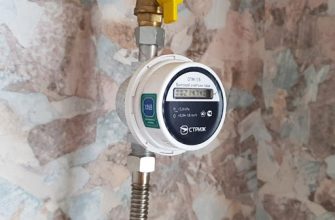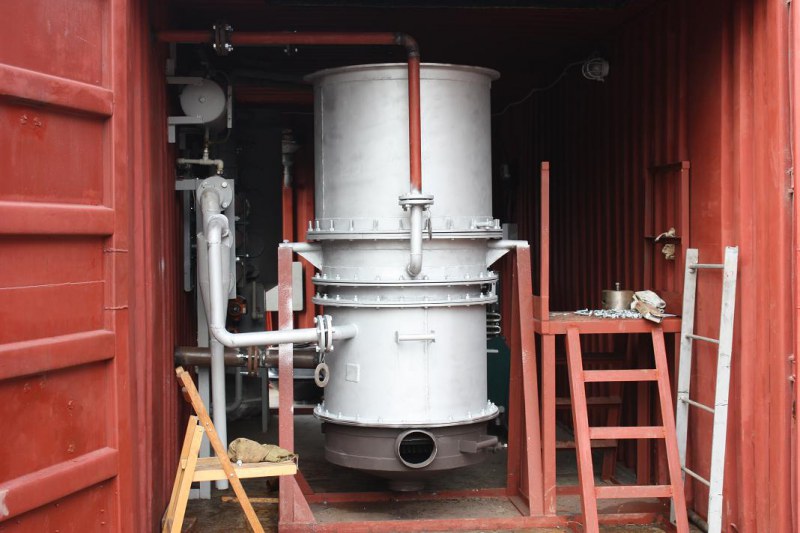Every farmer, regardless of his status, has to deal with the need to deal with the disposal of animal waste products. It takes a lot of investment to load, remove and dispose of waste. There is an effective and relative solution for converting excrement into money. The processing of manure into biogas is a technology that has been used for a long time in developed countries.
General information about biogas
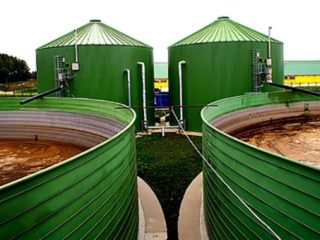
Manure contains many nutrients and minerals. In small quantities, it can be sold on a small farm, where there are beds and vegetable gardens. For medium and large farmers, waste disposal is a real headache. The accumulating heaps emit an intolerable odor, are sources of infection, and their contents are gradually losing their useful properties.
Biogas from manure has almost the same composition as natural gas used in municipal systems. The formation of flammable volatile compounds occurs due to the activity of anaerobic bacteria, for which organic raw materials are a food source. The substance they emit is 70% methane and 30% carbon dioxide. The first component is lighter than air, the second is heavier, which contributes to their natural separation without the use of mechanics and electronics. It remains to collect gas from manure and send it to consumers.
The benefits of producing biofuels at home don't end there. A high-quality fertilizer saturated with phosphorus and nitrogen remains in the bunker, having lost most of the pathogenic microorganisms that died in the absence of oxygen. The resulting gas is practically not inferior to natural analogues in its properties. In terms of the degree of heat transfer, 1 m³ is comparable to 1.5 kg of coal.
Conditions for the formation of gas from manure
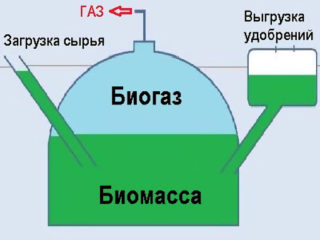
The combustible substance is the waste product of billions of bacteria that recycle organic residues that are produced by pets and poultry. For this process to occur intensively and continuously, appropriate conditions must be created. Methane of natural origin was formed in the bowels of the earth, in an area with a warm climate.
To get gas from manure, you need the following:
- Sealed tank. Oxygen in the air has a depressing effect on anaerobic bacteria. From this, their activity decreases, the production of combustible compounds is reduced to a minimum. In addition, the presence of oxygen contributes to the development of pathogens, harmful and dangerous to human health. We should not forget about the specific aromas that feces emit.
- Temperature conditions. Bacteria participating in the process of manure decomposition are activated and feel great at a temperature of + 30-50 ºС. To achieve this, it will be necessary to create reliable and effective thermal insulation for the manure container.
- Equipment for the collection, storage and transportation of the extracted raw materials to the house. You can buy the installation of the required type or make it yourself from scrap materials. The second method is cheaper, but requires more time and effort.
With the right approach to business, it is not difficult to obtain up to 4 liters of biofuel per 1 liter of the useful volume of the container.
Manure biogas technology
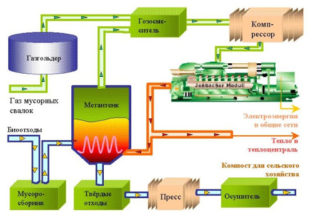
Extraction of gas from waste and its subsequent use as a fuel allows you to save on utilities and reduce the burden on the environment. With a large volume of raw materials obtained, it can be used to heat water and generate electricity.
The excrement of birds, fur-bearing animals, small, medium and large livestock is used as a raw material for the production of methane at home. It is allowed to include in the mixture tops, sawdust, grass, foliage, animal fats and offal left after slaughter.
Fuel is obtained as follows:
- Creation of a structure, which in its structure resembles the place where anaerobic bacteria live - the stomach. It's warm, dark and no oxygen.
- Preparation of the fermentation mixture. It should be 90% chlorine-free water. The solution is poured and the fermentation process begins almost immediately. Under properly created conditions, it lasts about 12 days.
- The waste material is pumped out, a new one is poured in instead. It is not necessary to add fresh bacteria, as they are already in the droppings.
- Biogas dehumidification. It contains a large amount of moisture, if the product is not processed, it will not burn.
- Collection of the received fuel. For this, tanks, barrels, plastic tanks or plastic bags are used.
Gas production units can be individual, for one house, or shared, supplying fuel to several farms specializing in animal husbandry.
Basic installation diagram
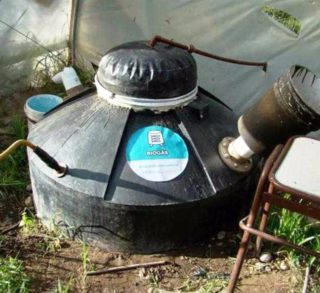
To extract biomethane from manure, you need to create an efficient installation in which the fermentation process will be intensively and continuously, caused by the activity of anaerobic bacteria. In order to process raw materials throughout the year, regardless of the air temperature, you should consider a heating system.
A typical basic installation consists of the following parts:
- Bioreactor. It is a tank with a capacity of 5-50 m³. The product has an inspection hatch, openings for the supply of raw materials, the withdrawal of fertilizers and the outflow of fermentation products. A device for mixing biomass of forced or natural action is also installed in the tank. The tank is lined with heat-insulating material to protect it from the cold.
- Loading container. Manure and other raw materials are dumped into it. After mixing with water, the substance is pumped into the reactor by a pump.
- Fertilizer collection container. It receives waste material rich in minerals and nutrients.
- Heating system. To maintain the desired temperature, a separate heater is installed under the tank or pipes from a biogas boiler are run along its perimeter.
- Pipeline. It houses a filter, valve, dryer and compressor. These structures take part of the substances released from the manure, but the quality of the gas increases significantly.
- Gas holder. It is located at the highest point of the structure. Designed for collection and storage of the finished product. The storage capacity corresponds to the estimated volume of gas produced. If the tank is metal, the gas is contained in it under a pressure of up to 12 atmospheres.
Some unit models are equipped with a control panel. This somewhat increases the cost of the product, but completely automates the biogas production process. The controller maintains the required temperature, mixes raw materials, removes gas, loads manure and pumps out waste material.
Getting gas from manure at home
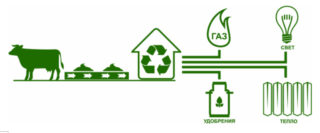
For the construction of a plant for obtaining gas from manure, there is no need to coordinate your plans with any authorities. This is a closed structure and does not pose a threat to soil, atmosphere and groundwater pollution.
The construction of the bioreactor is carried out in the following sequence:
- Determination of the location and size of the installation. Drawing up a diagram.
- Manufacturing or buying a finished tank. As an option for a small area - the construction of an underground tank made of reinforced concrete.
- Drilling holes for pipes, installing seals.
- Installation of a tank for manure and fertilizer intake.
- Laying of communications (supply and outlet pipes, heating circuit).
- Installation of a cylinder for collecting biogas. Arrangement of the connecting channel with a compressor, filter and water seal.
- Water and electricity supply.
- Thermal insulation and finishing of buildings, cleaning of the territory.
The mass must be constantly mixed so that it is homogeneous. This can be done manually or using an electric motor. A mixer is used, fixed on the upper wall of the reactor.
The extraction and use of biogas offers many benefits to farmers. The technology allows obtaining a large volume of free fuel for heating all buildings and high-quality organic fertilizers. With the right organization, the process of obtaining gas from manure can be brought into a separate profitable production. Don't forget about ecology. Burning gas is much safer than coal, fuel oil and firewood.


